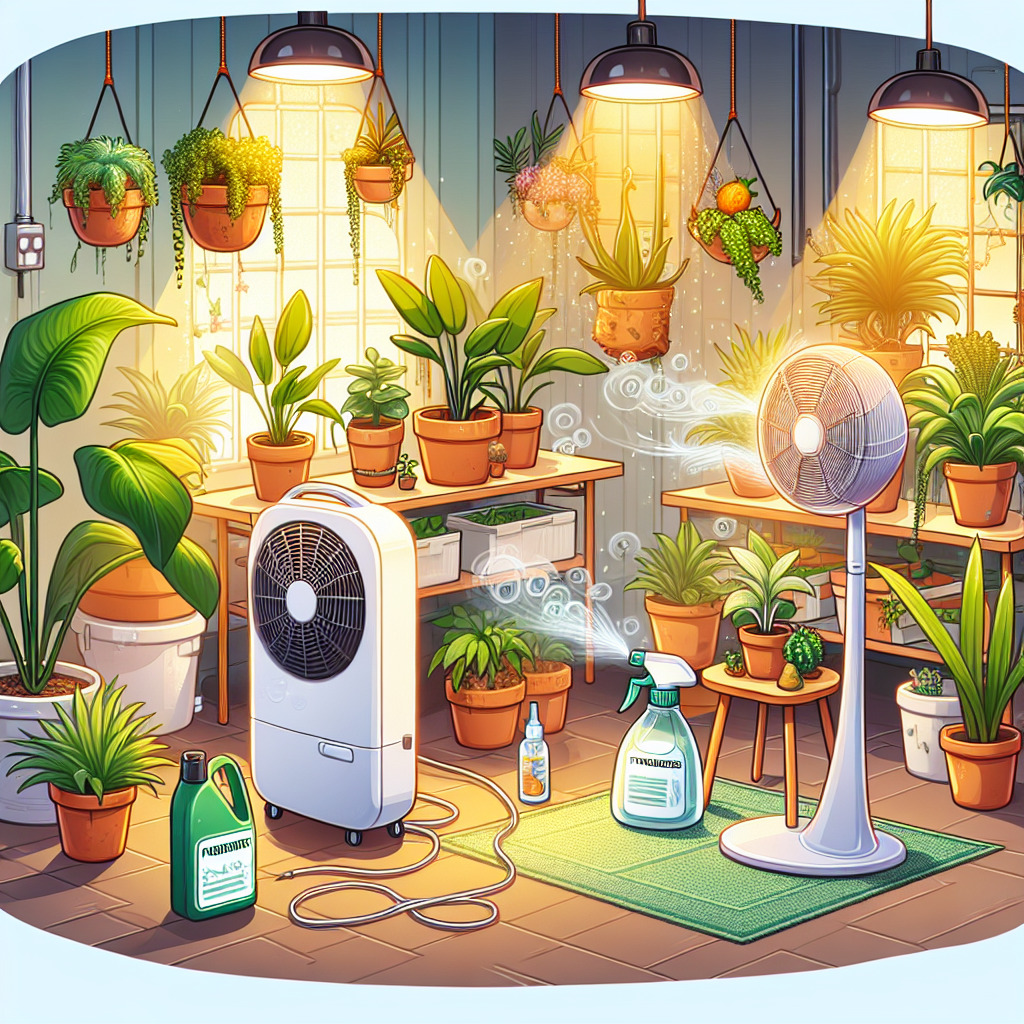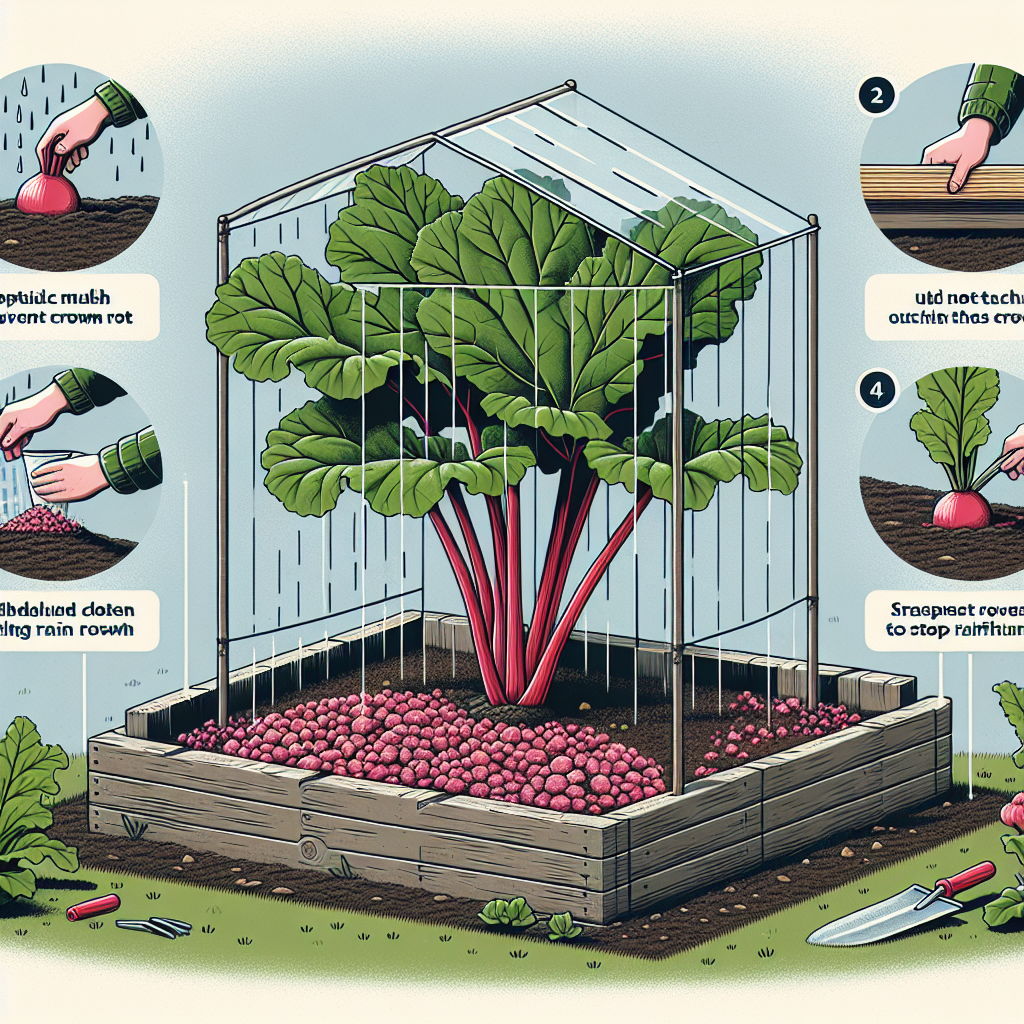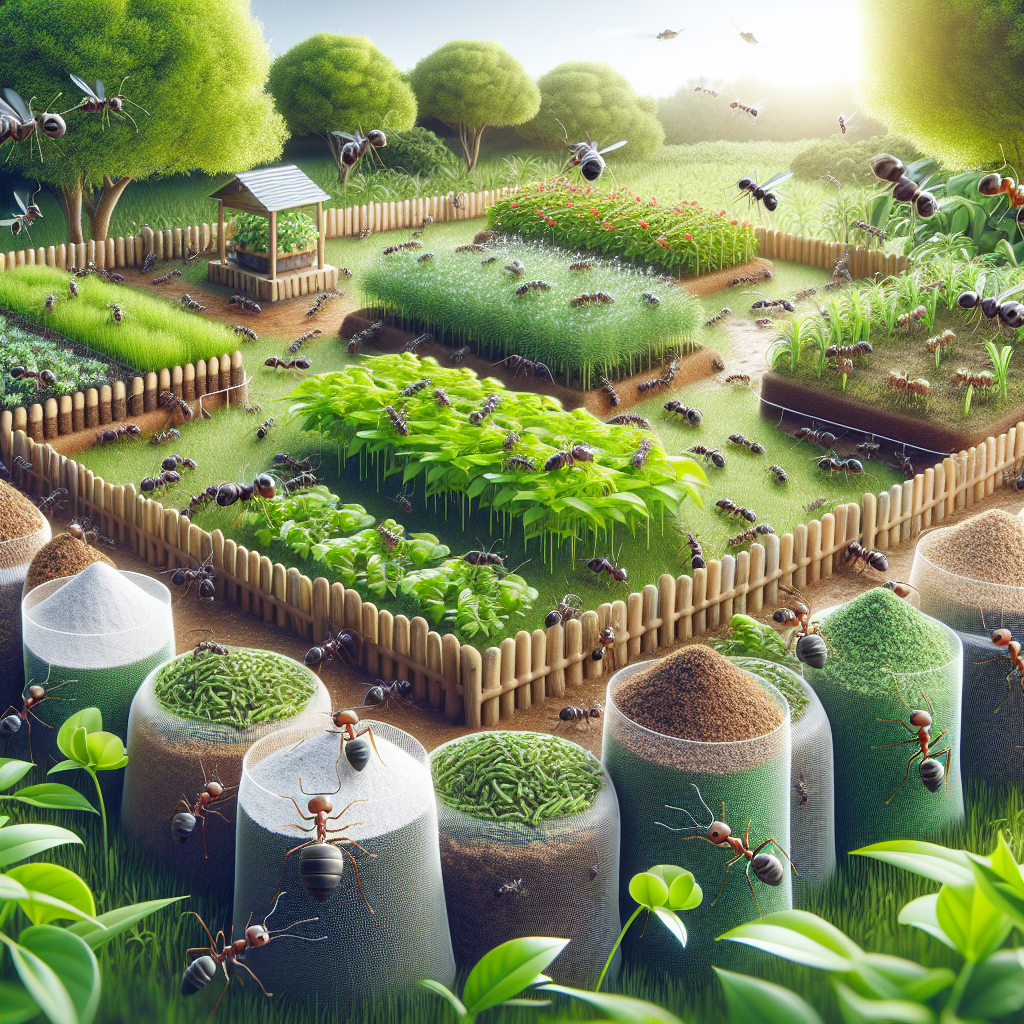Combating Mold and Mildew in Indoor Gardens
Updated February 25, 2025 at 2:17 am

The Importance of Monitoring Humidity in Your Indoor Garden
Indoor gardening can be a rewarding experience, but it comes with its own set of challenges. One of the major issues you might be dealing with is the persistent threat of mold and mildew. These unwelcome guests thrive in moist and humid environments, which can be common in indoor gardens if not properly managed. But fear not, with the right strategies and diligent care, you can keep your green haven healthy and flourishing. Let’s delve into some effective methods to combat mold and mildew in your lush indoor garden.
Understanding Mold and Mildew
Before we tackle the issue, it’s important to understand what mold and mildew are. They are both types of fungi that can grow on various surfaces, including plant soil and leaves. While mold is usually black or green and can penetrate beneath the surface it grows on, mildew is powdery, white or gray, and tends to stay on the surface. Both can be harmful to your plants and can cause health issues for you and your pets if not addressed.
Why Your Indoor Garden Might be At Risk
Several factors contribute to the growth of mold and mildew, such as poor airflow, overwatering, and inadequate light. These conditions create a humid microclimate which is ideal for fungi. Identifying these risks early can help you mitigate them and ensure that your indoor garden remains a healthy environment for both you and your plants.
Pet Friendly Measures Against Mold and Mildew
Pet Safe Fungicides: A safe start to protecting your indoor garden from mold and mildew includes using pet-friendly fungicides. Remember to always check the label for pet safety and opt for organic or natural fungicides when possible. One such product is the Garden Safe Brand Fungicide3, which serves as a fungicide, an insecticide, and a miticide, making it a versatile option.
Find This and More on Amazon
Light Requirements for Preventing Fungi
Proper Lighting: Adequate lighting ensures that your plants are healthy and can fight off mold and mildew naturally. Succulents and other sun-loving plants need plenty of light to prevent damp conditions where mold could flourish. LEDs designed for indoor gardens, like the SPIDER FARMER SF-2000 LED Grow Light, can simulate natural sunlight and provide the necessary spectrum for your plants to thrive. Reviews often highlight the energy efficiency and the full spectrum light output of these LED lights, which might be ideal for your garden’s needs.
Watering Techniques to Keep Mold at Bay
Manage Watering: Overwatering is a common cause for mold growth in indoor gardens. Let the soil dry out between waterings, and consider using self-watering planters or moisture meters to avoid excess water. Tools like the Thirsty Light Butterfly can alert you when your plants need water, helping you maintain the perfect balance.
Optimizing Humidity Levels
Control Humidity: Keeping humidity levels in check is critical. While some plants require a more humid environment, make sure it does not contribute to mold growth. Humidity gauges or hygrometers can help monitor the levels. For damp spaces, dehumidifiers are a good investment; models like the hOmeLabs 4,500 Sq. Ft Energy Star Dehumidifier are highly regarded for their efficiency in large spaces and user-friendly features.
Temperature Regulation
Maintain Consistent Temperatures: Fluctuating temperatures can encourage mold and mildew growth. A stable environment with temperatures ranging from 65 to 75 degrees Fahrenheit is generally recommended for most indoor plants. To manage this, smart thermostats can make real-time adjustments based on your settings.
Difficulty of Eradicating Mold and Mildew
While prevention is key, sometimes mold and mildew take hold despite your best efforts. Should this happen, removing the affected parts of the plant, along with any contaminated soil, is the first step. Then, applying a fungicide or a homemade solution like diluted hydrogen peroxide might be necessary to get rid of the fungi completely.
Recognizing the Early Signs of Mold and Mildew
Early detection is paramount. Keep an eye out for unusual spotting, discoloration, or a powdery substance on your plants. You might also notice an earthy or musty smell — that’s a telltale sign of mold presence. Catching these symptoms early allows you to intervene before the fungi can cause more damage.
Strategic Plant Placement to Improve Air Circulation
Improve Airflow: Good air circulation is essential. Stagnant air can create hotspots for moisture, which, in turn, can result in mold. Make use of fans or open windows to keep the air moving, being mindful not to place plants in drafty areas that could cause them stress. The strategic placement of plants will ensure they receive adequate air circulation.
Cleaning and Maintenance to Prevent Fungal Growth
Regular Clean-Up: A clean garden is a healthy garden. Regularly removing debris, fallen leaves, and spent blooms can vastly reduce the potential for mold and mildew growth. Establish a routine for checking and cleaning planters and trays as well to maintain a sanitary environment for your plants.
Choosing the Right Soil for Mold Prevention
Well-Draining Soil: The type of soil you use can greatly impact moisture levels. Choose a well-draining soil mix that allows for proper aeration and moisture control. Brands like FoxFarm Ocean Forest Potting Soil are widely praised for their good drainage and nutrient-rich composition, making it a suitable choice to prevent mold proliferation.
The Role of Pruning in Fungal Management
Prune Regularly: Pruning not only keeps your plants looking their best, but it also helps prevent disease. By removing dead or diseased foliage, you reduce the chances of mold and mildew taking hold. Make sure to use clean, sharp pruning tools to avoid infecting the plant with pathogens.
Natural Remedies and DIY Solutions
Use Natural Fungicides: Vinegar, baking soda, and neem oil are natural fungicides that many gardeners swear by. Such remedies can be less harsh on the plants while still effective against fungi. However, always test a small amount on your plants first to ensure they don’t react negatively.
Monitoring for Changes and Reacting Swiftly
Becoming familiar with your plants’ normal appearance and behavior will help you notice any changes that could signal a problem. This intimate knowledge allows for swift action and can be the difference between a small issue and a full-blown infestation.
Selecting Mold-Resistant Plants
When expanding your indoor garden, consider choosing plants that are resistant to mold and mildew. Some varieties are hardier when it comes to fighting off fungal infections. Research the plants that thrive in your specific indoor conditions to ensure a harmonious and healthy garden ecosystem.
Final Thoughts on Keeping Your Indoor Garden Healthy
Combating mold and mildew in an indoor garden does require vigilance, but it’s entirely possible with the right approach. By understanding the conditions that favor fungi and implementing preventive measures, you can maintain a vibrant, healthy indoor garden. The products mentioned, such as fungicides, soil mixes, and grow lights, all serve to enhance your gardening experience. Always remember to research and choose what best fits your garden’s needs, and consult with fellow plant enthusiasts to expand your knowledge. Happy gardening!
Professional Grade Solutions for Serious Fungus Issues
Professional Fungicides: In cases where mold and mildew persist, it may be time to consider stronger, professional-grade solutions. Products like BioAdvanced 3-in-1 Insect, Disease & Mite Control offer a more robust treatment for serious fungal problems. Its triple-action formula is designed to kill and control listed fungus, pests, and mites, and it’s suitable for use on flowers, shrubs, and trees. However, always take precautions to protect your pets and indoor air quality when using more potent chemicals.
Find This and More on Amazon
Importance of Isolating Infected Plants
Quarantine Affected Plants: To prevent the spread of mold and mildew, isolate any plants that show signs of infestation as soon as possible. By quarantining these plants, you can treat them individually and monitor their recovery without risking the health of your entire garden. This step is crucial in keeping the situation under control.
How Repotting Helps in Controlling Mold
Repot with Fresh Soil: If a plant is severely affected, repotting may be necessary. Remove the plant from its current container, gently shake off the old soil, and inspect the roots for any sign of decay. Trim off any unhealthy roots with sterilized scissors. Then, repot the plant in fresh, well-draining soil, which can help prevent future occurrences of mold and mildew.
Effective Air Purifying Plants to Combat Mold Spores
Enlist Air-Purifying Plants: Some plants help purify the air by absorbing pollutants and releasing clean oxygen. Incorporating air-purifying plants like spider plants, peace lilies, and snake plants into your indoor garden can act as a natural defense against air-borne mold spores. Not only do they enhance the aesthetic appeal of your space, but they also contribute to a healthier indoor environment.
Breve Reviews of Mold and Mildew Prevention Products
Let’s talk about a few products with solid reputations in the indoor gardening community. Firstly, the VIVOSUN Small Space Mini Dehumidifier is great for those with a compact indoor garden looking to manage humidity discreetly. Users often praise its quiet operation and efficiency in small apartments or rooms.
For monitoring, the Govee Temperature Humidity Monitor pairs with a smartphone app and gives accurate real-time readings. It has a wide fan base for its ease of use and the ability to track conditions even when you’re away from home.
Lastly, in terms of soil, Dr. Earth Organics Potting Soil gets a lot of love for its mycorrhizae and beneficial bacteria which support strong root development and may help suppress mold growth due to its excellent drainage properties.
Personal Protective Equipment (PPE) When Handling Fungicides
Always Stay Protected: When using any fungicides or mold treatments, personal safety should always be a priority. Ensure that you are properly outfitted with gloves, masks, and even goggles if necessary. This becomes especially important when handling potent chemical solutions that could potentially irritate skin or respiratory systems.
Utilizing Organic Options to Enhance Garden Health
Organic Additives: There are a host of organic options that can bolster your plant’s resistance to mold and strengthen their overall health. For instance, adding compost to your soil can introduce beneficial microorganisms that compete with mold. Cinnamon, a natural antifungal agent, can be sprinkled on the soil surface to help deter mold growth on seedlings and young plants.
Advanced Methods: Using UV Light to Sterilize Plants
UV Sterilization: For the tech-savvy gardener, UV light can be an effective way to kill mold spores without using chemicals. Ultraviolet germicidal irradiation (UVGI) is a sterilization method that uses UV light at sufficiently short wavelengths to disrupt the DNA of microorganisms. Using a UV-C lamp for short periods can help reduce the fungal load in your indoor garden, though caution should be exercised to avoid exposure to both plants and humans.
Long-Term Strategies to Prevent Mold and Mildew in Your Garden
Preventing mold and mildew is an ongoing process. Create a schedule that includes regular checks for humidity, temperature, and plant health. Research and implement companion planting, as some plants can improve the growing conditions for others, making your whole garden more resistant to mold. Additionally, maintain a clean environment and respond promptly to any signs of infestations. Your proactive efforts today will ensure the longevity and vigor of your indoor garden into the future.
When to Call a Professional for Mold Issues
If you’ve tried everything and still can’t get the mold under control, it might be time to consult a professional. Mold infestations can be stubborn, and a professional can offer specialized advice and treatments that are tailor-made for your particular situation. Remember, the health of your garden and your own should always take precedence.
Expert Tips on Increasing Plant Immunity to Disease
Building up your plant’s immunity is similar to how we look after our own health; providing them with the right nutrients and care is essential. By feeding them with a fortified fertilizer and ensuring they have the most suitable growing conditions, your plants will be more robust in their defense against mold and mildew. Certain brands like Miracle-Gro Plant Food have formulations designed to strengthen plants against environmental stressors.
It’s also recommended to give your plants an occasional foliar feed with a solution rich in trace elements and beneficial nutrients. These can boost your plant’s natural defenses and sometimes offer some level of preventive action against fungal issues. Homebrewed compost tea can also be an excellent organic solution for this purpose.
Community Support: Joining Forums for Shared Experience and Advice
One of the best ways to learn and troubleshoot gardening problems is by becoming part of a community. Online forums like GardenWeb or groups on social media platforms can be incredibly helpful. Experienced indoor gardeners often share their successful strategies for combatting mold and mildew, and you can apply their first-hand knowledge to your own situation.
Real-Life Scenarios: Case Studies on Overcoming Fungal Problems
Real-life examples provide some of the clearest insights into dealing with mold and mildew in indoor gardens. A common case study might detail an after-action report of an outbreak where a grower adjusted their watering schedule, improved air circulation with fans and pruned their plants more regularly. These practical examples serve as clear evidence that with persistence and proper care methodologies, overcoming mold and mildew issues is very achievable.
Implementing Smart Garden Technology for Precision Care
Technology can wield a significant advantage in your fight against indoor garden molds. Smart garden systems, with sensors connected to your smartphone, can provide precise monitoring of soil moisture levels, temperature, and light exposure. Products like the Click & Grow Smart Garden offer a hassle-free way to grow herbs and vegetables while reducing the risk of mold with their built-in LED lights and self-watering mechanisms.
How Mold and Mildew Affect Plant Growth and Yield
Mold and mildew can significantly impact plant growth and yield. Infected plants may exhibit stunted growth, yellowing leaves and can eventually succumb to disease if intervention is not swift. Understanding the repercussions of inaction emphasizes the importance of pre-emptive and responsive care in maintaining your indoor garden’s health.
Comparing Organic vs. Synthetic Mold Treatments
When it comes to treating mold, the debate between organic and synthetic approaches is ongoing. Organic treatments are generally safer for the environment and your home, but may take longer to work and need more frequent application. Synthetic treatments can be extremely effective and show quicker results. A product like Scotts DiseaseEx Lawn Fungicide is a synthetic option well-regarded for its fast action against a broad spectrum of lawn diseases, and while not for indoor use, it represents the efficacy of synthetic solutions.
Creating Your Proactive Mold Prevention Plan
Success in combatting mold and mildew lies in proactivity. Developing an integrated pest management plan that includes regular inspections, cleaning, targeted treatments, and environment adjustments can save you from reactionary stress. Detail your plan with schedules and procedures to ensure nothing slips through the cracks.
Wrap Up: Sustaining a Mold-Free Indoor Garden Oasis
Ultimately, sustaining an indoor garden that’s free from the invasion of mold and mildew boils down to a combination of knowledge, appropriate products, community wisdom, and the willingness to implement a solid prevention plan. Be vigilant in your observations and responsive to changes within your garden. With these approaches, you can enjoy the plethora of benefits that come with tending to a healthy, flourishing indoor garden.
Shop more on Amazon

